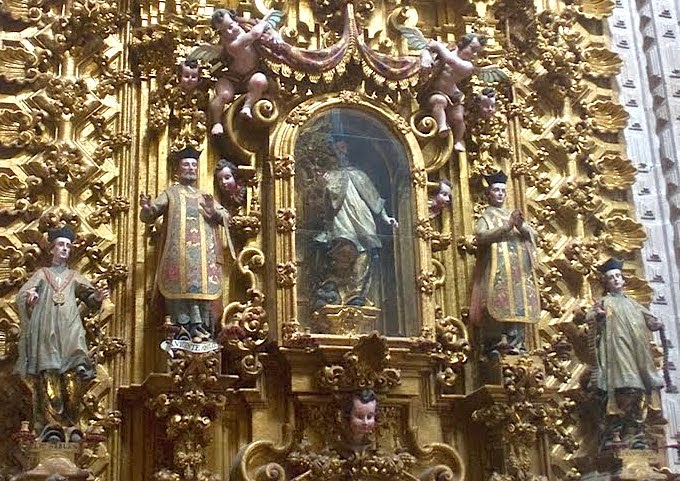The retablos in question are, along the north side of the nave, those of San José, San Juan Nepomuc and San Isidro. On the south side they are dedicated to Dolores, El Pilar and Santa Lucia (see plan below).
With the exception of the San Isidro and Santa Lucia altarpieces at the west end of the nave, all the retablos are outlined by broad, gilded borders incorporating a zigzagging vine encrusted with shells.
With the exception of the San Isidro and Santa Lucia altarpieces at the west end of the nave, all the retablos are outlined by broad, gilded borders incorporating a zigzagging vine encrusted with shells.
Framed by rounded, shell outlines they feature more open centers, with sumptuous, intensely sculptural niche-pilasters generally supplanting the estípites of the earlier retablos, exemplifying the minimally structured, more decorative anástilo manner of the terminal baroque style in altarpiece design.
In this post we look at the two retablos facing each other in the middle of the nave: those of the Virgin of Pilar and St. John Nepomuk.
Dedicated to the patron saint of the founder José de la Borda, this altarpiece is popularly called the retablo of the Archangels, all seven of whom are prominently featured.
The Virgin is ensconced in the canopied center vitrine, flanked by four of the lesser archangels. The better known figures of Michael, Gabriel and Raphael are featured in the upper section.
Designed in almost identical fashion to the retablo opposite, once again the principal saint, St. John Nepomuk, takes place of honor in the glassed in center niche.
And instead of archangels, the surrounding figures represent exemplary priests and martyrs from Church history—some obscure and other better known, such as St. Lawrence on the right and St. Vincent de Paul on the left.
Three Jesuit saints are displayed in the upper section, including St. Francis Xavier and St. Francis Borgia.
 |
| Santa Prisca: church plan with retablos (Tascolandia) |
text © 2014 Richard D. Perry. all images from Taxcolandia except where noted.
|
sources: Taxcolandia;
Elisa Vargas Lugo de Bosch: La iglesia de Santa Prisca de Taxco






No comments:
Post a Comment